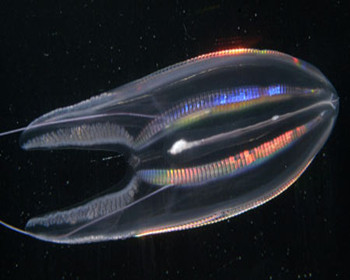Then there are the ctenophores (pronounced TEH-nuh-fores), which are such oddballs they've been placed in a phylum of their own. Also known as comb jellies, for the comblike rows of tiny paddles they use to swim, they tend to be small, delicate, and hard to study. They come in an array of weird body types: Some are flat and ribbonlike; others look more like pockets or little crowns. Most use an adhesive to nab their prey. "They have what's like exploding glue packets embedded in their tentacles," explains Steve Haddock, a senior scientist at the Monterey Bay Aquarium Research Institute.
此外还有栉水母(发音为TEH-nuh-fores),由于它们实在太古怪了,所以自成一门。它们也叫做comb jellies,这是来自它们用来游泳、一排排像梳子的栉板,这类动物往往体积小巧,非常脆弱,因此难以研究。栉水母有各式各样怪异的体形:有些呈扁平缎带状,有些看起来像口袋或小皇冠。大部分栉水母都会用一种黏液来捕捉猎物。“它们的触手里面埋着一种类似爆炸黏胶包的东西”,蒙特利湾水族馆研究所资深科学家史蒂夫·哈达克解释道。
In recent decades jellyfish populations in some parts of the world have boomed. In the 1980s a comb jelly that's known formally as Mnemiopsis leidyi and informally as the sea walnut showed up in the Black Sea. A native of the western Atlantic, it presumably had been transported in a ship's ballast water and then been discharged. In the Black Sea it reproduced so prolifically that by 1989 it had reached densities of up to 11 per cubic foot of water. Fish couldn't compete with the jellies for food -- sea walnuts eat as much as 10 times their body weight a day -- and many fish became food for the jellies. Local fisheries collapsed.
近几十年来,世界上有些地方的水母族群激增。20世纪80年代,一种官方名称叫梳状水母、俗称海胡桃的淡海栉水母出现在黑海。这种原生在大西洋西部的栉水母,可能是被船舰的压舱水运到黑海水域后排出。淡海栉水母在黑海大量繁殖,至1989年的密度已经高达每立方公尺海水有11只个体。当地的鱼类无法与淡海栉水母争夺食物(淡海栉水母每天会吃掉体重十倍的食物),许多鱼儿也成为栉水母的食物。结果就是,当地渔业崩溃了。

In other parts of the world, swarms of jellyfish have menaced swimmers and clogged fishing nets. In 2006, beaches in Italy and Spain were closed because of a bloom of jellyfish known as mauve stingers. In 2013 a Swedish nuclear plant temporarily shut down because moon jellies were blocking its intake pipes.
在世界上其他地方,成群的水母对泳客造成威胁,也堵塞了渔网。2006年,意大利与西班牙因为夜光游水母大量出现而关闭海滩。2013年,瑞典的一座核电厂因为海月水母堵住进水管而暂时关闭。
Situations like these led to a spate of reports that jellyfish were taking over the seas. One website warned of the "attack of the blob." Another predicted "goomageddon."
这类情况造成媒体上大量出现水母正接管海洋的报道。一个网站警告说“水母的攻击”。另一个则预测“水母大灾难”。
But scientists say the situation is more complicated than such headlines suggest. Jellyfish populations fluctuate naturally, and people tend to notice only the boom part of the cycle.
然而科学家表示,实际状况比这些头条新闻所言还更复杂。水母的族群数量本来就有自然波动,而大众往往只注意到周期中大量繁衍的时期。













